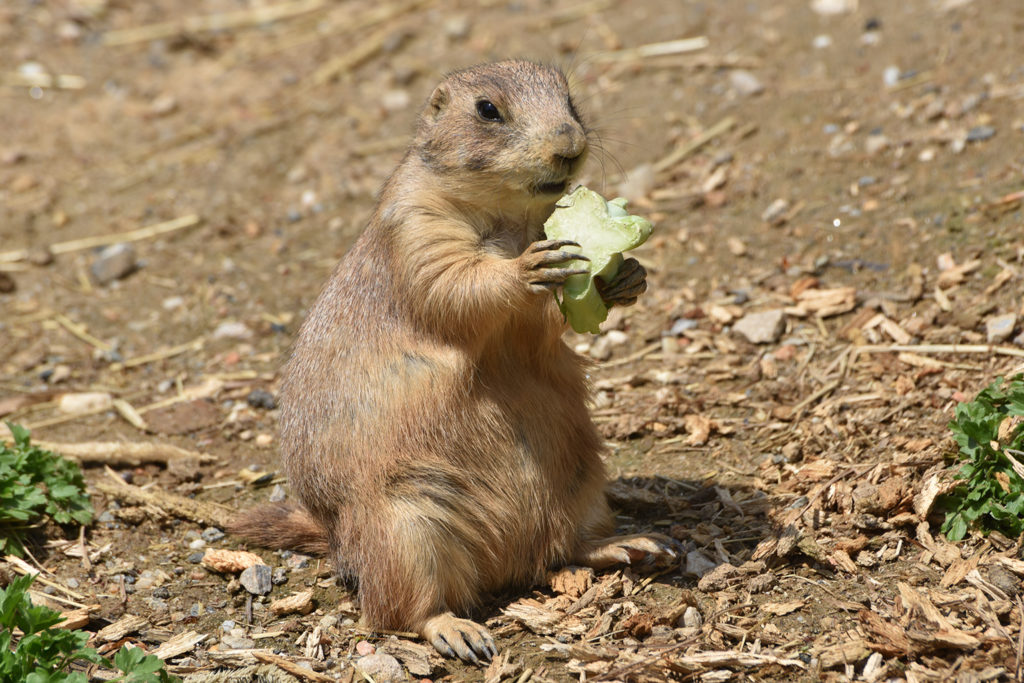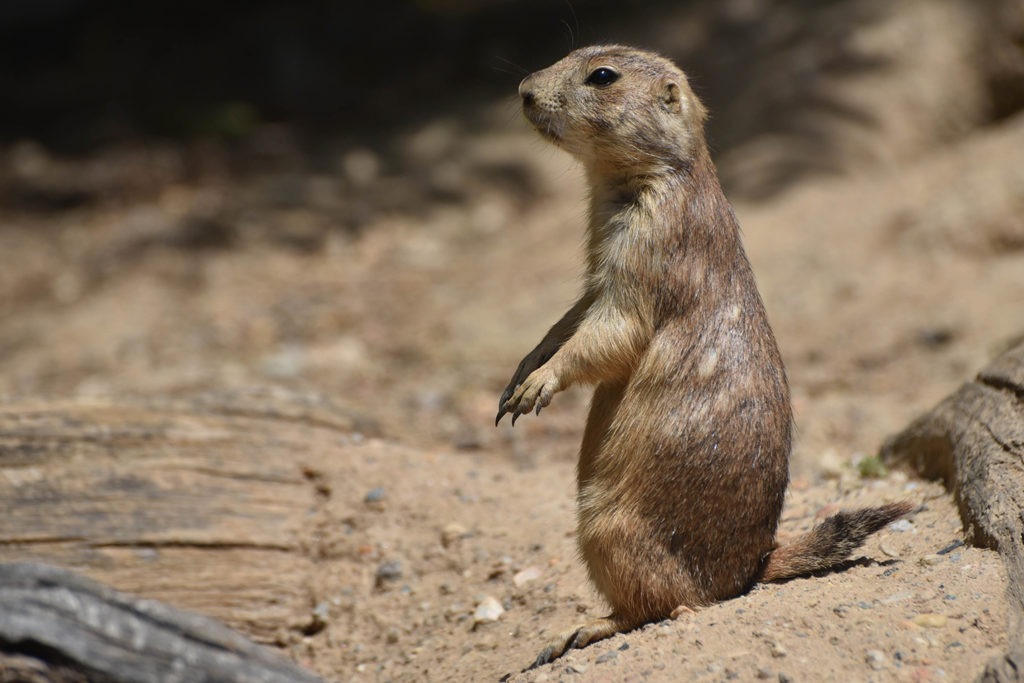Overview
“Where I live”
Prairie dogs inhabit short- and mid-grass American prairies. There are five recognized species of prairie dog and all are native to North America. The most common species is the black-tailed prairie dog, which is found primarily in the central United States, from the Canadian border to the Mexican border.
“How I live there”
Prairie dogs live in vast colonies that can house hundreds, thousands, and even millions of animals. Each colony is composed of individual family territories known as coteries. Most coteries consist of a single breeding adult male, three or four females, and their juvenile offspring. All members of a coterie share multiple underground burrows. These burrows are used for sleeping, nursing newborn young, escaping predators, and taking shelter from bad weather.
As males reach sexual maturity, they are chased away from their natal coteries and go off to establish their own burrows on the edge of the colony. There they will attempt to attract females and form their own coteries. Each family’s territory has to be large enough to supply food for all family members. Adult males defend their territory and will chase off interlopers from neighboring coteries.
Prairie dogs are wonderfully charismatic and busy rodents. They emerge from their burrows each day around sunrise and stay above ground until sunset. They spend the day digging, dusting, tidying, playing, squabbling, napping, foraging, eating, grooming, greeting relatives, chasing trespassers, keeping watch, sounding alarms, scurrying for cover, and slipping back into the sunshine once the coast is clear.
Prairie dogs return to their burrows at night to sleep. The main entrance to a burrow leads into a long shaft that may go down as many as 16 feet. Shorter side tunnels lead off the main shaft, ending in rounded lodges that are thickly lined with grass and hay. The lodges have to be far underground in order to minimize cave-ins and in order to protect prairie dogs through the winter when temperatures drop and frost penetrates deep into the ground. It gets very cold out on the prairies where there are no trees or bushes to buffer Arctic winds!
Black-tailed prairie dogs do not technically hibernate through the winter. They can be seen above ground any month of the year. However, they sleep more and eat less during the winter, so they are above ground less often and could rightfully be described as “dormant” during this time.
“Making my mark”
Prairie dogs have tremendous impact on the ecosystems they inhabit. They impact plant communities by constantly clipping the vegetation around them, not only to eat but also to maintain a clear watch for predators. They also impact a wide range of wildlife, ranging from mites and harvester ants to American bison. They are an important food source to many animals and their colonies attract many predators.
“What eats me”
A better question might be “what doesn’t eat a prairie dog, given the chance?” American badgers, bobcats, coyotes, long-tailed weasels, and black-footed ferrets will eat prairie dogs, as will foxes, mountain lions, and many species of raptor including golden eagles, northern harriers, peregrine falcons, prairie falcons, Cooper’s hawks, and red-tailed hawks. Rattlesnakes may move into abandoned burrows and prey on prairie dogs. Prairie dogs were also a food source to Native Americans. People still shoot prairie dogs, but more for recreation and eradication than actual hunting.
Raising young
Female prairie dogs give birth to one litter of 3-4 young per year. They give birth in underground nurseries and the young remain underground for about the first 6 weeks of life. Mothers return to nurse their young several times each day for the first two weeks, then only at night for the next several weeks. The babies’ eyes open around 5 weeks of age and they begin to explore their burrows. About a week later, they venture above ground and spend the days playing, feeding, and exploring together.
Infant mortality is very high among prairie dogs and, curiously, the major cause is infanticide — the killing of newborns by related kin. Infanticide occurs underground when the offspring are still very young. Much more research needs to be done to understand why there is such prevalence of infanticide among prairie dogs. However, initial data suggests that infanticide accounts for the partial or total loss of nearly 40% of all litters born within prairie dog colonies. The killers are usually closely related female kin – another remarkable fact.
Conservation
Two hundred years ago, the grasslands of western America teemed with black-tailed prairie dogs. Meriwether Lewis, while exploring the American Midwest, described their number as “infinite.” A more realistic estimate of their population then exceeds five billion. In the past two centuries, though, that population has decreased by 98%.
Their geographic range has shrunk almost as dramatically. Black-tailed prairie dogs once inhabited eleven American states and parts of Mexico and Canada. They now live in isolated populations associated mainly with protected lands. They inhabit narrow bands of short- to mid-grass prairies located in the U.S., between Mexico and Canada.
READ MORE:
The causes of their decline are many but without a doubt the most significant has been the persistent campaign of eradication perpetuated by American farmers and ranchers, often with government support and funding. Over the years, ranchers and farmers have shot and poisoned billions of prairie dogs and have converted millions of acres of prairie habitat to agricultural fields and pastures. Recently, plague has killed off millions more prairie dogs and urban development has eliminated some of the best remaining natural habitat.
The desire to eradicate prairie dogs stems from the reasonable yet misguided conclusion that they are a pest species. Starting in the 19th century with western pioneers, people began to assume that prairie dogs compete with livestock for food and that prairie dog colonies – pockmarked as they are with hundreds of burrow holes — pose significant risk of injury to livestock. In order to protect livestock, ranchers assumed that they needed to get rid of prairie dogs. Farmers assumed the same because they expected prairie dogs to eat and destroy cultivated crops. In fact, however, none of these assumptions about prairie dogs have proven true. They compete minimally, if at all, with livestock for food. There may be some overlap in dietary preference, but prairie dogs also graze on many plants that livestock avoid and encourage growth of some plants that cattle feed upon. Meanwhile, there have been very few reports of actual instances of livestock breaking legs from stepping in prairie dog burrow holes. And prairie dogs seek out wild short-grass prairies for their colonies and their food source, not cultivated fields.
By the 1970s, black-tailed prairie dogs were bordering on extinction. They have since rebounded somewhat but are not out of danger. In 2000, the U.S. Fish and Wildlife Service named them a candidate species for the Federal List of Threatened and Endangered Species. They are no longer classified as such, but they are still rare by historic measure. They also are still threatened by recreational shooting, poisoning, plague, and habitat loss.
Prairie dogs are resilient animals that could recover as a species if given half a chance. In order to do so, though, they need to be left alone on land where they can survive. They deserve to be left alone, too, because their presence in the natural environment is important to many other native plants and animals, and recent research suggests that they are far less detrimental to ranching and agricultural interests than once thought.
Staking out a future for prairie dogs will mean arriving at workable solutions with farmers and ranchers who have traditionally been so antagonistic towards them. Changing perceptions is part of the solution, but determining fair means of compensation for farmers and ranchers who sustain real losses because of prairie dogs is also necessary. In the end, there must be a better way than an ongoing, costly campaign of eradication that could result in the extinction of a native species and irreversible loss to America’s wildlife heritage.
Taxonomy
- Kingdom: Animalia
- Phylum: Chordata
- Subphylum: Vertebrata
- Class: Mammalia
- Order: Rodentia
- Family: Sciuridae
- Genera: Cynomys
- Species: ludovicianus



